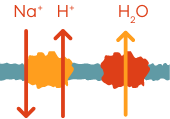Structurally identical to human uroguanylin with the exception of a single amino acid substitution for greater GC-C binding affinity1,2,4

Stimulates fluid secretion and increases intestinal transit, as demonstrated in animal models2,7

Acts in a pH-sensitive manner in the small intestine to facilitate fluid secretion8,a
Decreases the activity of pain-sensitive nerves in the intestine, based on animal studies9,10,a
aThe clinical significance of these data has not been established.
Trulance (plecanatide) 3 mg tablets is indicated in adults for the treatment of Chronic Idiopathic Constipation (CIC) and Irritable Bowel Syndrome with Constipation (IBS-C).
WARNING: RISK OF SERIOUS DEHYDRATION IN PEDIATRIC PATIENTS
Trulance® is contraindicated in patients less than 6 years of age; in nonclinical studies in young juvenile mice administration of a single oral dose of plecanatide caused deaths due to dehydration. Use of Trulance should be avoided in patients 6 years to less than 18 years of age. The safety and efficacy of Trulance have not been established in pediatric patients less than 18 years of age.
Please also see the full Prescribing Information, including BOXED Warning, for additional risk information.

